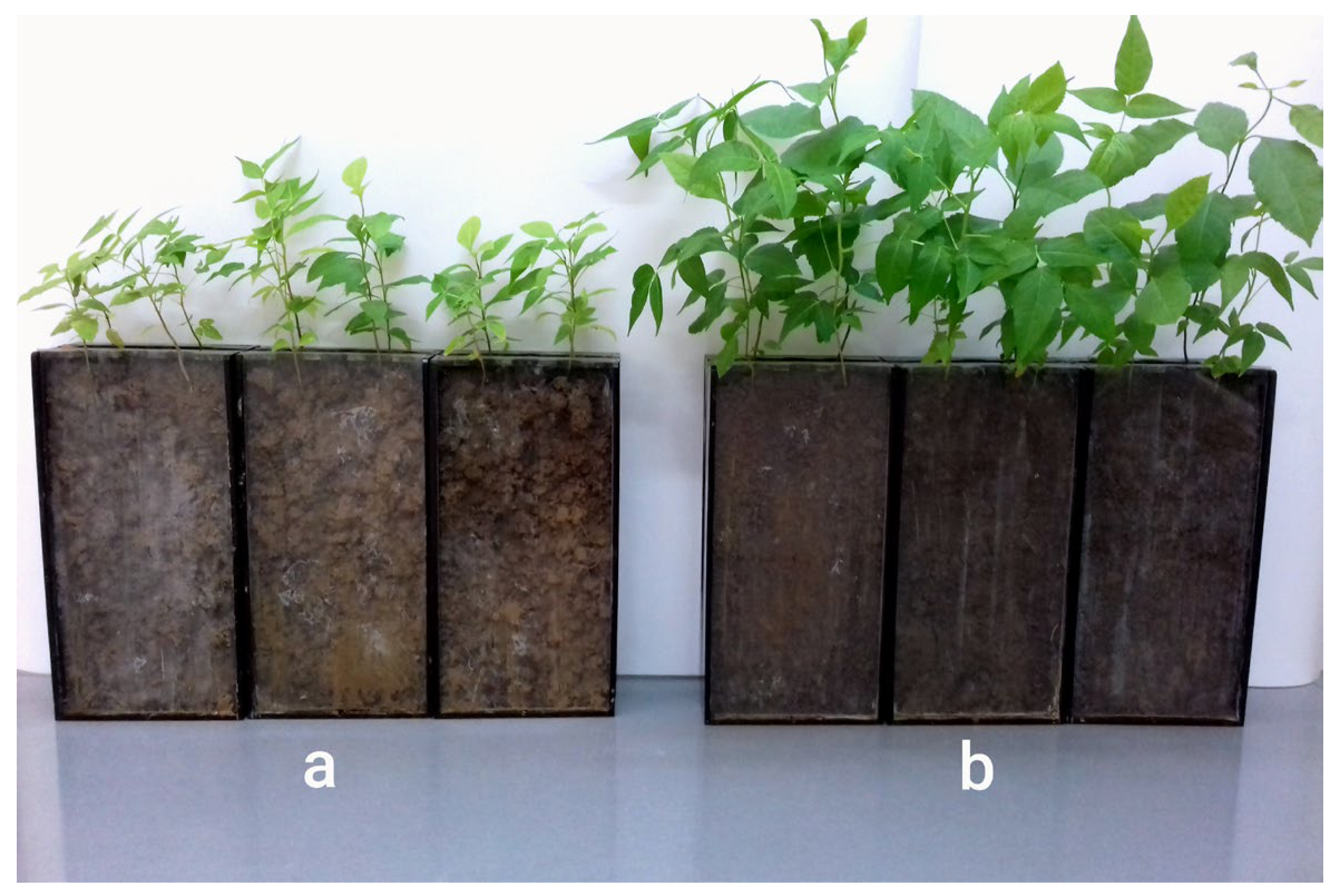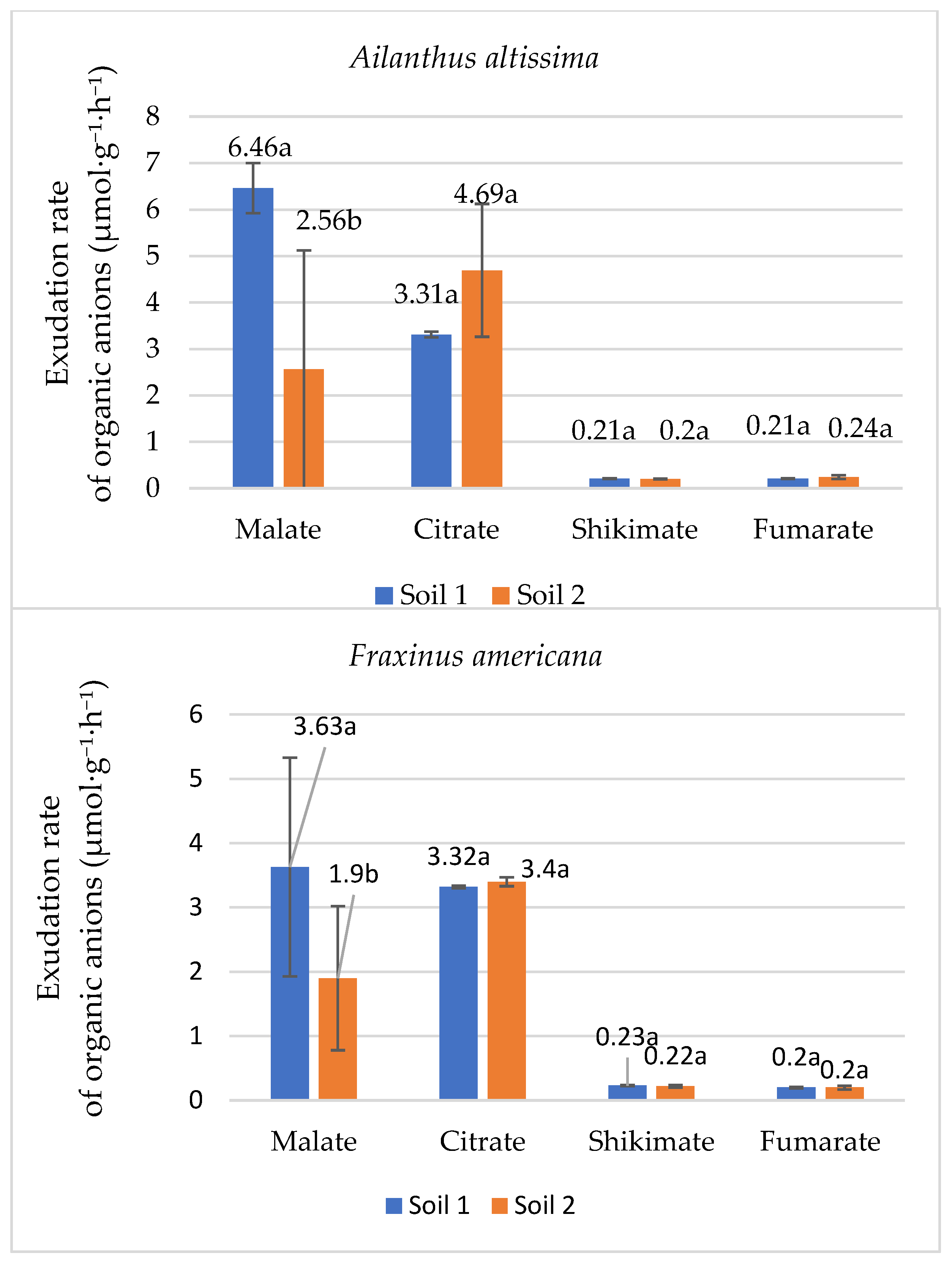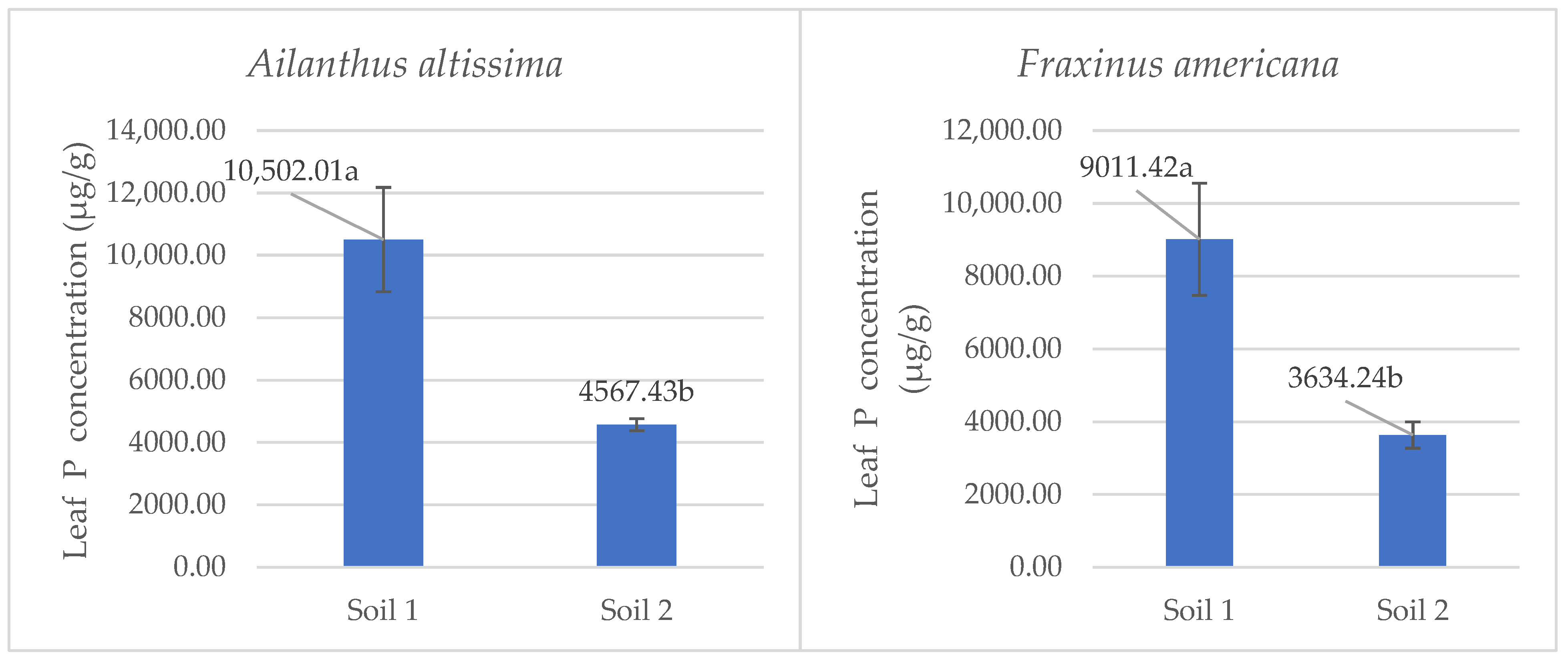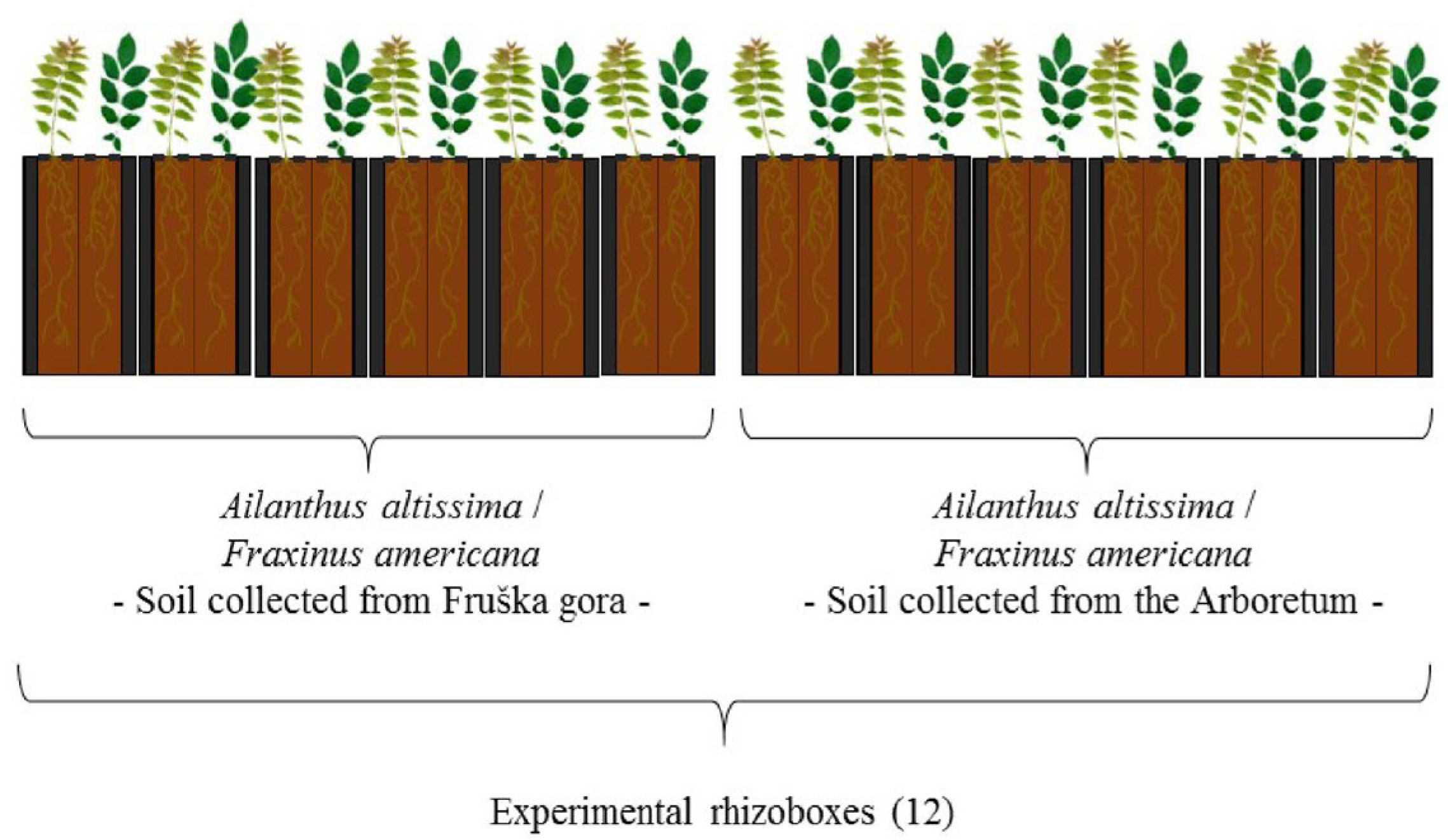Differential Responses of Invasive Trees Ailanthus altissima Mill. Swingle and Fraxinus americana L. to Soil Phosphorus Availability
Abstract
1. Introduction
2. Results
2.1. Soil Chemical Properties and Phosphorus Content in the Soil
2.2. Biomass Production in Response to Soil Phosphorus Availability
2.3. Lignin and Extractive Content in Plant Tissues
2.4. Root Exudation of Organic Anions Under Contrasting Phosphorus Availability in Soil
2.5. Leaf Phosphorus Content Under Contrasting Soil P Availability
3. Discussion
3.1. The Role of Phosphorus Availability on Biomass Production
3.2. Changes in Lignin and Extractive Content Depending on Phosphorus Availability
3.3. Organic Anion Root Exudation as a Response to Phosphorus Deficiency
3.4. Leaf Phosphorus Accumulation in Response to Contrasting Soil P Availability
4. Materials and Methods
4.1. Plant Material and Growing Conditions
4.2. Soil Sampling and Determination of Chemical Properties
4.3. Experimental Design
4.4. Laboratory and Experimental Analyses
4.4.1. Soil Analysis
4.4.2. Biomass Production
4.4.3. Lignin and Extractive Content in the Aboveground Plant Parts
4.4.4. Collection of Root Exudates and Determination of Organic Acids
4.4.5. Phosphorus Analysis in Leaf Tissue via Microwave Digestion and ICP-OES
4.5. Statistical Analysis
5. Conclusions
Author Contributions
Funding
Data Availability Statement
Acknowledgments
Conflicts of Interest
Correction Statement
References
- Grbović, F.; Branković, S.; Topuzović, M. Allelopatska aktivnost autohtnonih i invazivnih vrsta biljaka plavnih staništa Velike Morave (Allelopathic activity of native and invasive plant species of floodplain habitats of Velika Morava River). In Proceedings of the XXIII Savetovanje o biotehnologiji sa Međunarodnim Učešćem, Čačak, Serbia, 9–10 March 2018; University of Kragujevac: Kragujevac, Serbia, 2018; pp. 268–273. [Google Scholar]
- Ehrenfeld, J.G. Effects of exotic plant invasions on soil nutrient cycling processes. Ecosystems 2003, 6, 503–523. [Google Scholar] [CrossRef]
- Terzopoulou, P.; Kamperidou, V.; Barboutis, I. Utilization Potential of Tree-of-Heaven Species Biomass—A Review. Appl. Sci. 2023, 13, 9185. [Google Scholar] [CrossRef]
- Richardson, D.M.; Pyšek, P.; Rejmánek, M.; Barbour, M.G.; Panetta, F.D.; West, C.J. Naturalization and invasion of alien plants: Concepts and definitions. Divers. Distrib. 2000, 6, 93–107. [Google Scholar] [CrossRef]
- IUCN. IUCN Guidelines for the Prevention of Biodiversity Loss Caused by Alien Invasive Species; IUCN: Gland, Switzerland, 1999; pp. 31–32. [Google Scholar]
- Delivering Alien Invasive Species Inventories for Europe. Handbook of Alien Species in Europe. In Species Accounts of 100 of the Most Invasive Alien Species in Europe; Springer: Dordrecht, The Netherlands, 2009; pp. 269–374. [Google Scholar]
- Kožuharova, E.; Lebanova, H.; Getov, I.; Benbassat, N.; Kochmarov, V. Ailanthus altissima (Mill.) Swingle—A Terrible Invasive Pest in Bulgaria or Potential Useful Medicinal Plant? Bothalia 2014, 44, 213–230. [Google Scholar] [CrossRef]
- Lazarević, P.; Stojanović, V.; Jelić, I.; Perić, R.; Krsteski, B.; Ajtić, R.; Sekulić, N.; Branković, S.; Sekulić, G.; Bjedov, V. Preliminarni spisak invazivnih vrsta u Republici Srbiji sa opštim merama kontrole i suzbijanja kao potpora budućim zakonskim aktima. Časopis Zavoda za zaštitu prirode Srbije. J. Inst. Nat. Conserv. Serb. 2012, 10–11. [Google Scholar]
- de Groot, M.; Kozamernik, E.; Kermavnar, J.; Kolšek, M.; Marinšek, A.; Nève Repe, A.; Kutnar, L. Importance of Habitat Context in Modelling Risk Maps for Two Established Invasive Alien Plant Species: The Case of Ailanthus altissima and Phytolacca americana in Slovenia (Europe). Plants 2024, 13, 883. [Google Scholar] [CrossRef]
- Sladonja, B.; Sušek, M.; Guillermic, J. Review on Invasive Tree of Heaven (Ailanthus altissima (Mill.) Swingle) Conflicting Values: Assessment of Its Ecosystem Services and Potential Biological Threat. Environ. Manag. 2015, 56, 1009–1034. [Google Scholar] [CrossRef]
- University of Florida Plant Information Databases. Available online: https://hort.ifas.ufl.edu/database/documents/pdf (accessed on 1 October 2025).
- Callaway, R.M.; Ridenour, W.M. Novel weapons: Invasive success and the evolution of increased competitive ability. Front. Ecol. Environ. 2004, 2, 436–443. [Google Scholar] [CrossRef]
- Rorison, I. The Response to Phosphorus of Some Ecologically Distinct Plant Species. I. Growth Rates and Phosphorus Absorption. New Phytol. 1968, 67, 913–923. [Google Scholar] [CrossRef]
- Barker, A.V.; Pilbeam, D.J. Handbook of Plant Nutrition; CRC Press: Boca Raton, FL, USA, 2007. [Google Scholar]
- Dixon, M.; Simonne, E.; Obreza, T.; Liu, G. Crop Response to Low Phosphorus Bioavailability with a Focus on Tomato. Agronomy 2020, 10, 617. [Google Scholar] [CrossRef]
- Funk, J.L. The physiology of invasive plants in low-resource environments. Conserv. Physiol. 2013, 1, cot026. [Google Scholar] [CrossRef]
- Vance, C.P.; Uhde-Stone, C.; Allan, D.L. Phosphorus acquisition and use: Critical adaptations by plants for securing a nonrenewable resource. New Phytol. 2003, 157, 423–447. [Google Scholar] [CrossRef]
- Đunisijević-Bojović, D. Uticaj Koncentracije Olova i Kadmijuma u Zemljištu na Razvoj Drvenastih Biljaka. Ph.D. Thesis, Šumarski Fakultet, Univerzitet u Beogradu, Beograd, Serbia, 2013. [Google Scholar]
- Lambers, H.; Raven, J.A.; Shaver, G.R.; Smith, S.E. Plant nutrient-acquisition strategies change with soil age. Trends Ecol. Evol. 2008, 23, 95–103. [Google Scholar] [CrossRef]
- Đunisijević-Bojović, D.; Đukić, M.; Maksimović, V.; Skočajić, D.; Suručić, L. The Effects of Iron Deficiency on Lead Accumulation in Ailanthus altissima (Mill.) Swingle Seedlings. J. Environ. Qual. 2012, 41, 1517–1524. [Google Scholar] [CrossRef]
- Plaxton, W.C.; Tran, H.T. Metabolic adaptations of phosphate-starved plants. Plant Physiol. 2011, 156, 1006–1015. [Google Scholar] [CrossRef] [PubMed]
- Canarini, A.; Kaiser, C.; Merchant, A.; Richter, A.; Wanek, W. Root exudation of primary metabolites: Mechanisms and their roles in plant responses to environmental stimuli. Frontiers in Plant Science 2019, 10, 157. [Google Scholar] [CrossRef] [PubMed]
- Huang, X.F.; Chaparro, J.M.; Reardon, K.F.; Zhang, R.; Shen, Q.; Vivanco, J.M. Rhizosphere interactions: Root exudates, microbes, and microbial communities. Botany 2014, 92, 267–275. [Google Scholar] [CrossRef]
- Nešić, M.; Obratov-Petković, D.; Skočajić, D.; Bjedov, I.; Đukić, M.; Đunisijević-Bojović, D. Allelopathic Potential of the Invasive Species Aster lanceolatus Wild. Period. Biol. 2016, 118, 1–7. [Google Scholar] [CrossRef]
- Nešić, M.; Đunisijević-Bojović, D. Alelopatski potencijal invazivnih vrsta. In Ukrasne i Invazivne Biljke u Uslovima Klimatskih Promena—Uticaji i Adaptacije; University of Belgrade: Beograd, Serbia, 2017; pp. 106–123. ISBN 978-86-7299-240-3. [Google Scholar]
- Ferguson, J.J.; Rathinasabapathi, B.; Chase, C.A. Allelopathy: How Plants Suppress Other Plants. Hortic. Sci. 2013, 2013, 1–5. [Google Scholar] [CrossRef]
- Weidenhamer, J.D.; Callaway, R.M. Direct and indirect effects of invasive plants on soil chemistry and ecosystem function. J. Chem. Ecol. 2010, 36, 59–69. [Google Scholar] [CrossRef]
- Bueno, A.; Pritsch, K.; Simon, J. Species-Specific Outcome in the Competition for Nitrogen Between Invasive and Native Tree Seedlings. Front. Plant Sci. 2019, 10, 337. [Google Scholar] [CrossRef]
- Liu, Q.; Luo, L.; Zheng, L. Lignins: Biosynthesis and biological functions in plants. Int. J. Mol. Sci. 2018, 19, 335. [Google Scholar] [CrossRef] [PubMed]
- Frei, M. Lignin: Characterization of a Multifaceted Crop Component. Sci. World J. 2013, 436517. [Google Scholar] [CrossRef] [PubMed]
- Boerjan, W.; Ralph, J.; Baucher, M. Lignin biosynthesis. Annu. Rev. Plant Biol. 2003, 54, 519–546. [Google Scholar] [CrossRef] [PubMed]
- Plass, W.T. An Evaluation of Trees and Shrubs for Planting Surface-Mine Spoils; Res. Pap. NE-317; Department of Agriculture, Forest Service, Northeastern Forest Experiment Station: Upper Darby, PA, USA, 1975; p. 8. [Google Scholar]
- Schuetz, M.; Benske, A.; Smith, R.A.; Watanabe, Y.; Tobimatsu, Y.; Ralph, J.; Demura, T.; Ellis, B. Laccases direct lignification in the discrete secondary cell wall domains of protoxylem. Plant Physiol. 2014, 166, 798–807. [Google Scholar] [CrossRef]
- Vanholme, R.; De Meester, B.; Ralph, J.; Boerjan, W. Lignin biosynthesis and its integration into metabolism. Curr. Opin. Biotechnol. 2019, 56, 230–239. [Google Scholar] [CrossRef] [PubMed]
- Alami, M.M.; Guo, S.; Mei, Z.; Yang, G.; Wang, X. Environmental factors on secondary metabolism in medicinal plants: Exploring accelerating factors. Med. Plant Biol. 2024, 3, e016. [Google Scholar] [CrossRef]
- Isah, T. Stress and defense responses in plant secondary metabolites production. Biol. Res. 2019, 52, 39. [Google Scholar] [CrossRef]
- Khan, A.; Kanwal, F.; Ullah, S.; Fahad, M.; Tariq, L.; Altaf, M.T.; Riaz, A.; Zhang, G. Plant Secondary Metabolites—Central Regulators Against Abiotic and Biotic Stresses. Metabolites 2025, 15, 276. [Google Scholar] [CrossRef]
- Akula, R.; Ravishankar, G.A. Influence of abiotic stress signals on secondary metabolites in plants. Plant Signal. Behav. 2011, 6, 1720–1731. [Google Scholar] [CrossRef]
- Luo, R.; Kuzyakov, Y.; Zhu, B.; Qiang, W.; Zhang, Y.; Pang, X. Phosphorus addition decreases plant lignin but increases microbial necromass contribution to soil organic carbon in a subalpine forest. Glob. Change Biol. 2022, 28, 4194–4210. [Google Scholar] [CrossRef]
- Fujii, K. Plant strategy of root system architecture and exudates for acquiring soil nutrients. Ecol. Res. 2024, 39, 623–633. [Google Scholar] [CrossRef]
- Sun, W.; Li, Q.; Qiao, B.; Jia, K.; Li, C.; Zhao, C. Advances in Plant–Soil Feedback Driven by Root Exudates in Forest Ecosystems. Forests 2024, 15, 515. [Google Scholar] [CrossRef]
- De Andrade, S.A.L.; Borghi, A.A.; De Oliveira, V.H.; Gouveia, L.D.M.; Martins, A.P.I.; Mazzafera, P. Phosphorus Shortage Induces an Increase in Root Exudation in Fifteen Eucalypts Species. Agronomy 2022, 12, 2041. [Google Scholar] [CrossRef]
- Veneklaas, E.J.; Lambers, H.; Bragg, J.; Finnegan, P.M.; Lovelock, C.E.; Plaxton, W.C.; Price, C.A.; Scheible, W.-R.; Shane, M.W.; White Ph, J.; et al. Opportunities for improving phosphorus—Use efficiency in crop plants. New Phytol. 2012, 195, 306–320. [Google Scholar] [CrossRef] [PubMed]
- Jones, D.L. Organic acids in the rhizosphere—A critical review. Plant Soil 1998, 205, 25–44. [Google Scholar] [CrossRef]
- Richardson, D.M.; Pyšek, P. Plant invasions: Merging the concepts of species invasiveness and community invasibility. Prog. Phys. Geogr. 2006, 30, 409–431. [Google Scholar] [CrossRef]
- TAPPI T 257 cm-02; Sampling and Preparing Wood for Analysis. Technical Association of the Pulp and Paper Industry: Atlanta, GA, USA, 2002.
- TAPPI T 264 cm-97; Preparation of Wood for Chemical Analysis. Technical Association of the Pulp and Paper Industry: Atlanta, GA, USA, 1997.
- ASTM D1105-21; Standard Test Method for Preparation of Extractive-Free Wood. ASTM International: West Conshohocken, PA, USA, 2021.
- TAPPI T 222; Standard Test Method for Acid-Insoluble Lignin in Wood. Technical Association of the Pulp and Paper Industry: Atlanta, GA, USA, 2011.
- TAPPI UM 250; Acid-Soluble Lignin in Wood and Pulp. Technical Association of the Pulp and Paper Industry: Atlanta, GA, USA, 1991.
- Wu, Q.; Zhang, S.; Feng, G.; Zhu, P.; Huang, S.; Wang, B.; Xu, M. Determining the optimum range of soil Olsen P for high P use efficiency, crop yield, and soil fertility in three typical cropland soils. Pedosphere 2020, 30, 832–843. [Google Scholar] [CrossRef]






| Parameters | Soil 1 | Soil 2 |
|---|---|---|
| pH in H2O | 8.2 | 7.4 |
| EC in H2O (dS·m−1) | 0.14 | 0.07 |
| CEC (cmolc kg−1) | 27 | 22 |
| Organic matter (%) | 1.7 | 0.3 |
| CaCO3 (%) | 1.3 | 1 |
| Total N (g kg−1) | 1.0 | 0.5 |
| Olsen P (mg kg−1) | 9 | 27 |
| Exchangeable K (mg kg−1) | 167 | 189 |
| Exchangeable Ca (mg kg−1) | 4712 | 3414 |
| Exchangeable Mg (mg kg−1) | 360 | 512 |
| Available B (mg kg−1) | 0.84 | 0.35 |
| Available Fe (mg kg−1) | 16 | 35 |
| Available Cu (mg kg−1) | 1.4 | 1.55 |
| Available Mn (mg kg−1) | 16 | 9.6 |
| Available Zn (mg kg−1) | 1.56 | 0.15 |
| Available Mo (mg kg−1) | 0.034 | 0.030 |
| Species Name | Type of Soil * | Part of the Plants (Mean Values **) | Root/Shoot Ratio | |
|---|---|---|---|---|
| Root | Shoot | |||
| Fraxinus americana | Soil 2 | 0.19 a ± 0.06 | 0.70 a ± 0.16 | 0.27 b ± 0.11 |
| Soil 1 | 0.13 a ± 0.03 | 0.18 b ± 0.03 | 0.72 a ± 0.21 | |
| Ailanthus altissima | Soil 2 | 0.09 a ± 0.02 | 0.63 a ± 0.14 | 0.14 b ± 0.05 |
| Soil 1 | 0.10 a ± 0.03 | 0.23 b ± 0.04 | 0.44 a ± 0.15 | |
Disclaimer/Publisher’s Note: The statements, opinions and data contained in all publications are solely those of the individual author(s) and contributor(s) and not of MDPI and/or the editor(s). MDPI and/or the editor(s) disclaim responsibility for any injury to people or property resulting from any ideas, methods, instructions or products referred to in the content. |
© 2025 by the authors. Licensee MDPI, Basel, Switzerland. This article is an open access article distributed under the terms and conditions of the Creative Commons Attribution (CC BY) license (https://creativecommons.org/licenses/by/4.0/).
Share and Cite
Milutinović, M.; Đunisijević-Bojović, D.; Maksimović, V.; Kostić Kravljanac, L.; Popović, J.; Marković, M. Differential Responses of Invasive Trees Ailanthus altissima Mill. Swingle and Fraxinus americana L. to Soil Phosphorus Availability. Plants 2025, 14, 3204. https://doi.org/10.3390/plants14203204
Milutinović M, Đunisijević-Bojović D, Maksimović V, Kostić Kravljanac L, Popović J, Marković M. Differential Responses of Invasive Trees Ailanthus altissima Mill. Swingle and Fraxinus americana L. to Soil Phosphorus Availability. Plants. 2025; 14(20):3204. https://doi.org/10.3390/plants14203204
Chicago/Turabian StyleMilutinović, Marijana, Danijela Đunisijević-Bojović, Vuk Maksimović, Ljiljana Kostić Kravljanac, Jasmina Popović, and Marija Marković. 2025. "Differential Responses of Invasive Trees Ailanthus altissima Mill. Swingle and Fraxinus americana L. to Soil Phosphorus Availability" Plants 14, no. 20: 3204. https://doi.org/10.3390/plants14203204
APA StyleMilutinović, M., Đunisijević-Bojović, D., Maksimović, V., Kostić Kravljanac, L., Popović, J., & Marković, M. (2025). Differential Responses of Invasive Trees Ailanthus altissima Mill. Swingle and Fraxinus americana L. to Soil Phosphorus Availability. Plants, 14(20), 3204. https://doi.org/10.3390/plants14203204








